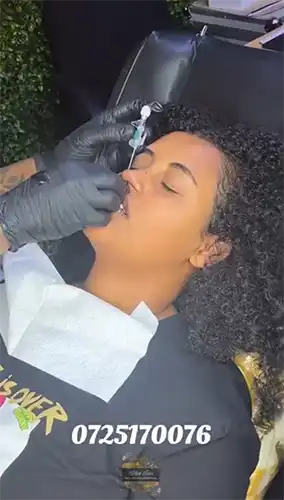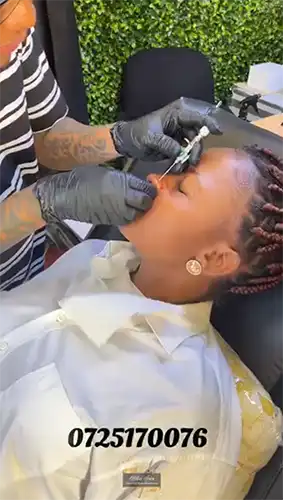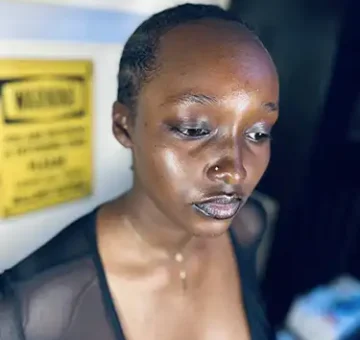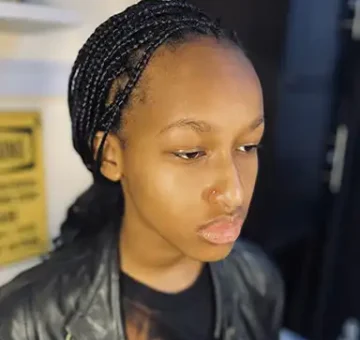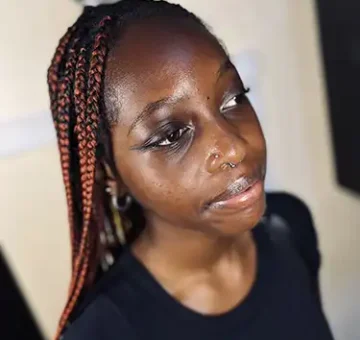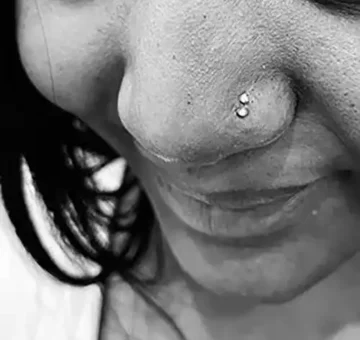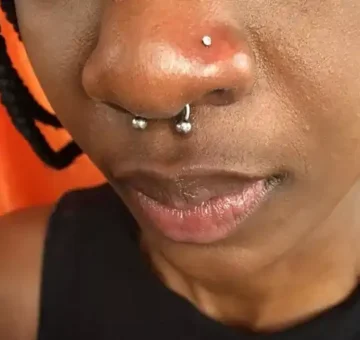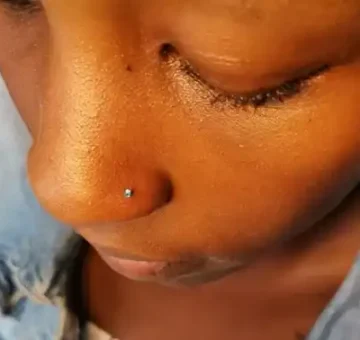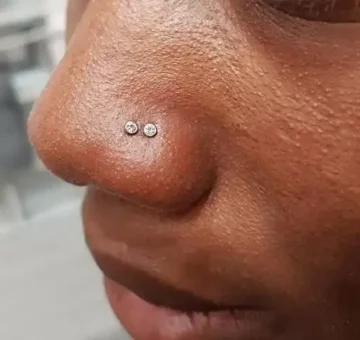Nose Piercings
Key Features of Nose Piercing:
- Procedure:
– A professional piercer uses a sterilized needle to create a puncture.
– Jewelry such as a stud or ring is inserted immediately after. - Common Locations:
– Nostril: On the side of the nose.
– Septum: The soft cartilage between the nostrils.
– Bridge: The surface skin on the bridge of the nose. - Cultural Significance: Nose piercings hold deep cultural and historical importance in many societies, especially in India, the Middle East, and Africa, symbolizing beauty, marital status, or wealth.
- Modern Appeal: It’s a popular fashion statement and a means of personal expression globally.
- Jewelry Choices: Available options include studs, hoops, rings, and ornate clickers, catering to varied styles and preferences.
Nose Piercing Variations
There are several variations of nose piercings, each with a unique placement and aesthetic appeal. Here’s a breakdown of the most popular types:
- Nostril Piercing
– Placement: On the fleshy part of the nostril, either left or right.
– Jewelry Options: Studs, hoops, or L-shaped pieces.
– Popularity: Most common and versatile nose piercing. - High Nostril Piercing
– Placement: Higher up on the nostril than a standard nostril piercing.
– Jewelry Options: Small studs due to limited space.
– Appearance: Subtle yet distinctive. - Septum Piercing
– Placement: Through the thin, soft tissue (columella) between the nostrils.
– Jewelry Options: Circular barbells, captive bead rings, or clickers.
– Popularity: Edgy and fashionable, with the option to hide it by flipping the jewelry. - Bridge Piercing
– Placement: On the skin across the bridge of the nose, between the eyes.
– Jewelry Options: Straight barbells.
– Appearance: Bold and non-traditional, often categorized as a surface piercing. - Nasallang Piercing
– Placement: A combination piercing that goes through one nostril, the septum, and exits through the other nostril.
– Jewelry Options: Straight barbell.
– Popularity: Rare and requires an experienced piercer. - Vertical Tip Piercing (Rhino Piercing)
– Placement: Vertically through the tip of the nose.
– Jewelry Options: Curved barbells.
– Appearance: Unique and striking. - Austin Bar Piercing
– Placement: Horizontally through the tip of the nose but doesn’t pass through the septum.
– Jewelry Options: Straight barbells.
– Popularity: Rare and highly distinctive.
Choosing the Right Piercing
The best nose piercing for you depends on:
- Face shape: Some placements highlight facial features better than others.
- Lifestyle: Septum piercings are easily hidden, while bridge piercings are more visible.
- Pain tolerance: Areas with more cartilage, like the nostril or septum, might cause more discomfort.
Nose Piercing Process
Choosing a Reputable Piercing Studio: Start by researching and selecting a reputable piercing studio with experienced piercers who follow strict hygiene and safety standards. Look for recommendations and read reviews to ensure you choose a trustworthy establishment.
- Consultation:
– When you arrive at Rebel Inks Tattoo, Tattoo Removal, and Body Piercings Parlour studio, you’ll typically have a consultation with one of our piercer. During this discussion, you can express your preferences for jewelry and the type of nose piercing you want.
– Our piercer will examine your nose to ensure it’s suitable for piercing and discuss any potential risks and complications. - Preparation:
– Before the piercing, our piercer will thoroughly clean the area around your nose using an antiseptic solution.
– They may use a sterile marker or pen to mark the precise spot where the piercing will go. The placement will be centered and aligned with your preferences. - Piercing:
– With the markings in place, our piercer will use a sterilized needle to create a hole through the tissue of your nose. The needle is typically hollow and cleanly removes a small section of tissue to create a hole.
– Immediately after creating the hole, the chosen jewelry (usually a small stud or hoop) will be inserted into the newly created piercing. - Final Adjustments:
– Our piercer will ensure that the jewelry is securely in place and properly positioned.
– They will provide you with instructions on how to care for your new piercing, including aftercare guidelines. - Aftercare Instructions:
– After the piercing, our piercer will provide you with detailed aftercare instructions. Following these instructions diligently is crucial for a successful healing process.
– Aftercare typically involves cleaning the piercing with a saline solution and avoiding certain products, such as alcohol-based cleansers, which can irritate the piercing.
Considerations before getting a Nose Piercing
Getting a nose piercing can be an exciting way to express your individuality, but it’s important to think through a few considerations beforehand. Here’s a guide to help you prepare:
- Health Considerations
– Allergies: Ensure you’re not allergic to common jewelry materials like nickel. Opt for titanium or surgical-grade stainless steel for safety.
– Medical Conditions: If you have diabetes, keloid scarring tendencies, or a compromised immune system, consult a doctor before proceeding.
– Pregnancy: Avoid getting piercings while pregnant due to increased infection risks. - Professional Studio Selection
– Reputation: Research and choose a reputable studio with experienced piercers.
– Hygiene Standards: Verify the use of sterilized equipment and a clean workspace. - Pain Tolerance and Healing Time
– Pain Level: Nose piercings typically involve a brief, sharp pinch. Pain varies depending on the piercing type (nostril, septum, etc.).
– Healing Time: 2-4 months
– Be prepared for aftercare throughout the healing process. - Jewelry Selection
– Choose initial jewelry made from hypoallergenic materials like titanium, niobium, or 14k gold.
– Opt for simple designs for easier cleaning and faster healing. - Lifestyle and Workplace Policies
– Check if your workplace or school has policies against visible piercings.
– For discretion, consider a septum piercing with a flip-up retainer. - Aftercare Commitment
– Nose piercings require diligent aftercare, including cleaning twice daily with saline solution.
– Avoid swimming, makeup around the area, and touching the piercing with unwashed hands during the healing period. - Potential Risks
– Infections: Improper aftercare or unhygienic conditions can lead to infections.
– Scarring: Bumps or keloids may form if the piercing is irritated or improperly cared for.
– Jewelry Reactions: Poor-quality jewelry can cause irritation or allergic reactions. - Financial Investment
– Expect to pay for the piercing, high-quality jewelry, and aftercare products.
– Cheap piercings often come with risks; prioritize quality over cost. - Emotional Preparedness
– Consider how a piercing aligns with your personal style and comfort level.
– Be ready for attention and questions about your new look.
Pain and Healing for a Nostril Piercing
Pain Level
- During the Procedure:
– Pain is typically described as a sharp pinch or sting, lasting only a few seconds.
– The discomfort level is moderate and generally tolerable for most people. - After the Procedure:
– Slight throbbing, swelling, or tenderness is common in the first few days.
– Pain subsides significantly within a week if proper aftercare is followed.
Healing Process
- Initial Healing (0–4 Weeks):
– The piercing may feel tender and appear slightly swollen.
– A small amount of clear or white discharge (lymph fluid) is normal. - Mid-Healing (1–3 Months):
– The piercing begins to stabilize, and irritation should decrease.
– Avoid changing the jewelry during this phase unless directed by your piercer. - Complete Healing (2–4 Months):
– Full healing depends on individual factors like skin type, aftercare, and lifestyle.
– Cartilage piercings like nostrils take longer to heal than soft-tissue piercings.
Potential Issues During Healing
- Infections: Symptoms include redness, warmth, excessive swelling, and pus. Seek professional advice if these occur.
- Piercing Bumps: Often caused by irritation or improper aftercare. Treat with saline soaks or consult your piercer.
- Jewelry Rejection: Rare but can happen if unsuitable jewelry is used. Choose high-quality materials like titanium or gold.
Nostril Piercing Aftercare Guide
Proper aftercare is essential to ensure your nostril piercing heals smoothly and minimizes the risk of infection or irritation. Here’s a comprehensive guide:
- Cleaning Routine
– Saline Solution:
→ Use a sterile saline spray or prepare a DIY solution (1/4 tsp of non-iodized sea salt in 1 cup of warm distilled water).
→ Clean the area twice daily—morning and evening.
– Application:
→ Soak a cotton ball or pad with the saline solution.
→ Gently press it against the piercing for 5 minutes to remove debris and soothe irritation.
→ Pat dry with a clean paper towel; avoid using cloth towels to prevent bacteria transfer. - Avoid Irritants
– Don’t touch or twist the jewelry unnecessarily; only handle it with clean hands.
– Avoid applying makeup, creams, or lotions near the piercing.
– Refrain from swimming in pools, hot tubs, or natural water bodies during the initial healing phase.
– Keep hair, glasses, and face masks from rubbing or irritating the area. - Lifestyle Adjustments
– Sleeping:
→ Sleep on your back to prevent pressure on the piercing.
→ Use clean pillowcases to reduce bacterial exposure.
– Diet: Stay hydrated and eat a balanced diet to support healing.
– Avoid Smoking: Smoking can introduce bacteria and prolong healing. - Jewelry Care
– Don’t change the jewelry until the piercing is fully healed (2–4 months).
– Use high-quality materials like titanium, niobium, or gold to avoid allergic reactions.
– If the jewelry becomes loose or falls out, contact your piercer immediately. - Signs of Trouble
– Normal Healing Signs: Redness, slight swelling, and a small amount of clear or whitish discharge are typical in the first weeks.
– Warning Signs:
→ Persistent redness, warmth, or excessive swelling.
→ Yellow, green, or foul-smelling discharge.
→ Pain that worsens over time rather than improving.
*For any signs of infection, Contact Us Immediately. - Long-Term Care
– Even after healing, clean your piercing occasionally to prevent buildup.
– Avoid removing the jewelry for extended periods to prevent closure.
Nostril Piercing Jewelry Guide
The jewelry you choose for your nostril piercing can enhance your style while ensuring comfort and proper healing. Here’s a breakdown of the types, materials, and styles to consider:
Types of Jewelry
Nostril Studs
- L-Shaped Studs:
– Easy to insert and stays secure.
– Great for everyday wear. - Straight Pins:
– Require a backing to secure the jewelry.
– Often used for custom or unique designs. - Screw-Style Studs:
– Twists into place, offering a snug fit.
– Ideal for active lifestyles as they rarely fall out.
Nostril Rings
- Hoops:
– Circular rings that hug the nostril.
– Can be plain or decorative. - Captive Bead Rings (CBRs):
– Feature a small bead to secure the ring.
– Versatile and stylish.
Nose Bones
- Features a small ball at the end to keep the jewelry in place.
- Easy to insert but may not be suitable for new piercings.
Clickers
- Hinged rings that “click” into place.
- Available in intricate designs, perfect for a bold statement.
Jewelry Materials
For Initial Piercings
- Titanium: Hypoallergenic, lightweight, and ideal for sensitive skin.
- Surgical Stainless Steel: Affordable and durable; suitable for most people.
- Niobium: Hypoallergenic and slightly more flexible than titanium.
- 14K or 18K Gold: Must be nickel-free and smooth. Avoid gold-plated options.
For Healed Piercings
- Platinum: Luxurious and non-reactive.
- Glass: High-quality borosilicate or quartz glass for a unique look.
- Decorative Metals: Options like rose gold or black titanium for style, but ensure they’re safe for wear.
Jewelry Sizes
- Gauge (Thickness):
– Standard size is 18G (1.0mm) or 20G (0.8mm) for nostril piercings.
– Consult our piercer before switching sizes. - Diameter (Rings): Typically 8mm–10mm for hoops, depending on nose shape and placement.
Styles and Designs
- Minimalist: Simple studs or plain hoops for a classic look.
- Decorative: Studs with gemstones, intricate designs, or charms.
- Statement: Bold clickers or large hoops for a dramatic effect.
Choosing the Right Jewelry
- Healing Phase: Stick to basic, high-quality materials that minimize irritation.
- Lifestyle: If you lead an active lifestyle, choose secure options like screw-style studs or clickers.
- Occasion: Select simple jewelry for daily wear and save decorative pieces for special occasions.
Cost of a Nostril Piercing in Nairobi, Kenya
The cost of a nostril piercing varies depending on factors like location, piercer expertise, jewelry choice, and the studio’s reputation. Here’s a general breakdown:
Average Cost Range
- Standard Cost:
Ksh. 1,000 – Ksh. 1,500 (excluding jewelry).
Jewelry Costs
- Basic Jewelry:
– Titanium or surgical steel: Ksh. 250 – Ksh. 500 - Premium Jewelry:
– Gold (14k/18k): Ksh. 1,000 –Ksh. 3,000
– Platinum or designer pieces: Ksh. 2,500 – Ksh. 4,500
Additional Costs
- Aftercare Products: Saline sprays or cleaning solutions: Ksh. 500 – Ksh. 1,000
- Jewelry Upgrades: Switching to decorative or statement jewelry after healing may cost more.
Nostril Piercing Cost Breakdown Table
Package Component | Estimated Cost (KSh) | Details / Notes |
Piercing procedure only | 1,000 – 1,500 | Rebel Inks standard rate |
Premium jewelry upgrade | 500 – 3,000 | Titanium to gold/platinum range |
Aftercare kit (saline, cleaning kit) | 500 – 1,000 | Sold separately at some studios |
Basic Package (Reputable) | 1,500 – 1,500 | Procedure + starter jewelry |
Standard Package | 1,750 – 2,000 | Mid-range piercing with basic jewelry |
Full-Service Package (High-End) | 2,500 – 6,500 | Includes upgrades, better jewelry, and aftercare |
Factors Influencing Cost
- Studio Reputation: Renowned studios with certified piercers often charge more.
- Piercer Experience: More experienced piercers may have higher fees. At Rebel Inks Tattoos, Tattoo Removal, and Body Piercings Parlour we have experienced professionals who offer quality and premium services.
- Location: Prices vary by city or region. Urban areas and upscale neighborhoods tend to be pricier. Rebel Inks Tattoos, Tattoo Removal, and Body Piercings Parlour is located in the heart of the Central Business Disrict (CBD) in Nairobi, Kenya, and is easily accessible to both locals and foreigners in the country.
- Jewelry Material: High-quality, hypoallergenic materials cost more but are safer for healing.
Possible side effects of Nostril Piercing
While nostril piercings are generally safe when done professionally, there are potential side effects to consider. Proper aftercare can minimize these risks, but here’s what to watch for:
- Common Side Effects
– Initial Discomfort
→ Mild pain, swelling, and tenderness are typical after the procedure.
→ Temporary redness around the piercing site is normal.
– Discharge
→ Clear or whitish fluid (lymph) may form a crust around the piercing.
→ This is a natural part of the healing process. - Potential Complications
– Infection
→ Symptoms: Redness, warmth, severe swelling, yellow/green discharge, or fever.
→ Cause: Poor aftercare, touching with unclean hands, or exposure to bacteria.
→ Solution: Clean regularly with saline and consult a piercer or doctor if symptoms worsen.
– Piercing Bumps
→ Types:
— Irritation Bumps: Caused by jewelry movement or improper cleaning.
— Hypertrophic Scarring: Raised, thick tissue around the piercing.
→ Solution: Saline soaks and avoiding unnecessary handling.
– Keloid Formation
→ Raised scars that can develop due to genetics or improper healing.
→ Seek medical advice if keloids form. - Allergic Reactions
– Symptoms: Itching, redness, and rash around the piercing.
– Cause: Reaction to jewelry materials, especially nickel.
– Solution: Use hypoallergenic jewelry like titanium, niobium, or gold. - Jewelry Rejection or Migration
– The body pushes the jewelry out, leading to displacement or closure of the piercing.
– Caused by unsuitable jewelry, improper placement, or individual anatomy. - Prolonged Healing
– Cartilage piercings (like nostril piercings) take longer to heal than soft-tissue piercings.
– Delayed healing may occur due to irritation, poor aftercare, or health conditions. - Swelling and Blockage
– Swelling might make it difficult to breathe through the nostril temporarily.
– Improperly sized jewelry can cause irritation or embed in the skin. - Nasal Complications
– Jewelry might accidentally dislodge or fall into the nostril.
– Allergies or colds can irritate the piercing during healing.
Prevention and Care
- Follow aftercare instructions diligently (clean twice daily with saline).
- Avoid touching or rotating the jewelry unnecessarily.
- Choose an experienced piercer and high-quality materials.
Get In Touch
For more information on the list above and any other special services,please call or come in for free consultation
Testimonials
I am extremely happy with my new 'Safari' tattoo from Eric at Rebel Inks! The quality of the artwork is fantastic. Eric is a true professional and an amazing artist.
The preparation and design process was thorough and collaborative. He was very patient with my specific requests, including making sure all the elements, which hold personal meaning, were perfect.
The service was friendly and highly professional from start to finish. Despite the 8-hour session, Eric was a pleasant person to spend the time with.
The aftercare guidance and follow-up have been excellent and careful, which has made the healing process easy and better than expected.
I highly recommend Eric for anyone looking for a thoughtful, talented, and caring tattoo artist.
I recommend them 💯
I would definitely recommend if you’re thinking of getting a piercing!
The staff were super friendly, explained everything clearly, and made me feel so at ease. They answered all my nervous questions (and I had many questions),
They walked me through the whole process, gave detailed aftercare instructions, and even followed up afterward to check how I was healing 🫶
Clean, professional, and full of good vibes.
Would 100% recommend . Definitely making a second trip here.
This was the second tattoo I got and I wish I could have come to Eric for my first one! He gave me really great after-care directions for the tattoo as well as a little jar of his own Vaseline-type stuff to put over my tattoo while it was healing! He even put second skin over my tattoo so that I didn’t have to worry about it for the first few days. Now THAT’S good service. My first tattoo artist didn’t do none of that lol.
After the session Eric didn’t rush me and my friend out, he chatted with us and even when he found out I was an artist too— really encouraged me to keep creating and to find a community of artists to support me. I almost cried because I’ve had such a hard time with my own art the past couple of years, it meant so much to me to have a fellow very talented artist say that to me. 🤍🤍🤍
Eric you’re amazing, don’t ever stop creating and just know you’ve impacted lives all over the world!🫶🏻 thanks so much for everything!!
From the moment I walked in, Eric was professional, welcoming, and attentive. He made sure I was comfortable throughout, provided everything I needed, and explained every step of the process. The tattooing itself was unbelievably smooth - I genuinely felt no pain compared to my previous tattoos over the last 22 years.
Eric also gave me excellent aftercare guidance and products, and thanks to that, my tattoo healed beautifully. The attention to detail, precision, and shading are absolutely stunning. This is hands-down the best tattoo I've ever had, and I will be flying back to Nairobi for any future ink.
If you want incredible art, a professional experience, and a talented artist who truly cares about his clients, Rebel Ink is the place to go!
From start to finish, the service was exceptional. The piercer was professional, knowledgeable, and made me feel completely comfortable. The cleanliness of the place was above and beyond — everything was spotless and hygienic, which really put me at ease. Highly recommend for anyone considering a piercing!
Shout out to Eric😘
We ended up changing the jewelry three times to ensure I had the best fit and avoided any signs of rejection, and he always listened to my suggestions as a client, which I really appreciated. Now, three months in, my piercing is healing beautifully, with no sign of rejection. Highly recommend for anyone who values a piercer who cares about your comfort and healing journey!
What stood out the most was the aftercare Eric checked in with me even three weeks later to see how the tattoo was healing. That kind of follow-up shows how much he truly cares about his work and his clients.
I’m very satisfied and will definitely be coming back for my next piece. Highly recommend!
The piercing wasn't as painful as I had thought and the process was quick and satisfactory. I love it!!!
The piercing is healing well thanks to the aftercare instructions and follow-up. I would highly recommend Rebel Inks
Eric also did a belly button piercing for a friend, guiding her through the process, doing the piercing and then explaining the after care to her.
The shop is on the 3rd floor, with the entrance to the stairs near an alleyway on the left. The shop is perfect size, clean, and attractive looking. The mural is pretty dope.
Thank you for the amazing service! 🔥👅✨
I got piercibgs there and the process was really good. My biggest concern was hygiene but that wasn't an issue at all, they use new needles and they sanitize them.
The service itself was also welcoming.
I was informes of everything i needed to know beforehand.
10/10 would recommend!
Eric was so calm and patient with my almost 2 year old lady. It was such a clean and hygienic process. We will definitely be back for our second rounds of piercings and maybe even another tattoo!
They assess the area before any art and advise one accordingly. They also give one post clean up process and also do a check up after the body art projects. Overall, I loved my experience and I’m hooked. 👍
Will definitely come back next time I’m in town 🙂
He listened to what I actually wanted and made sure he could fit in the time before I flew back home.
The shop is clean & private and is easy enough to find.
Eric has even checked in a couple of times since to make sure all is good.
I would totally recommend Eric! I absolutely love my Elephants!
I had a very easy healing period and always follow up from Eric to check on my progress...I would highly recommend if you are a first timer because from my experience all went very well and attention to detail
Thank you for a good job and looking forward to send all my friends your way
And all the best with the new year 2025!
From the moment I walked in, the staff was super friendly and made me feel at ease. The studio had a clean, professional atmosphere, which immediately put me at ease. My piercer was incredibly skilled and explained every step of the process, ensuring I was comfortable the entire time. The piercing was quick and practically painless, and the aftercare instructions were clear and easy to follow. I can tell they really care about the health and safety of their clients.
Overall, a fantastic experience—I highly recommend Rebel Inks and Tattoos for anyone looking to get pierced or tattooed!
They do follow up after their services
Eric's Studio isn’t just a place to get a tattoo—it’s an experience. The combination of professionalism, artistic talent, and a welcoming environment makes it a standout destination for anyone considering a tattoo.
I highly recommend Eric’s Studio to both first-timers and seasoned tattoo enthusiasts. If you’re looking for a high-quality tattoo and an enjoyable experience, this is the place to go.
I would definitely recommend their services again and again
Thank you Rebel Ink
My piercings are healing ❤️🩹 well
I would 💯 recommend
I will definitely come back for more .
Two, all the equipments he used for the piercings were new and/or sterilised.
Three, the parlour itself was very clean and was up to par with the hygiene standards.
Four, Eric provided effective aftercare instructions, making sure I knew exactly how to take care of my new piercings and he kept in touch and continues to do so, to check on the healing progress.
I highly highly highly recommend this place!!!
Would definitely recommend them to friends and go back for other piercings
Not only was the piercing process smooth, but he also provided thorough aftercare instructions, making sure I knew exactly how to take care of my new piercings. What really impressed me was that he keeps in touch to check on how the healing is progressing – a sign of true care for his clients.
The shop maintains a high standard of hygiene, and the atmosphere is welcoming and comfortable, which really added to the positive experience. I highly recommend this place to anyone looking for a professional and caring experience. I’ll definitely be coming back for any future piercings!
My appreciation for the excellent customer service I received. The follow-ups were prompt, and I truly appreciated the gentleness and professionalism throughout. Thank you!"
"Looking for professional eyebrow microshading removal? Look no further!"
The customer care is top tier 👌🏾👌🏾.
Wonderful place to get tattoos and piercings. 💯💯
Eric goes ahead to follow up on his clients progress and gives good advice each time I reach out to him.
I would recommend Reble tattoos anytime.
Good job bro we really appreciate.
Ohh and the price is very fair.
The environment was clean , procedure was sterile and the jewelry used are of the best quality.
He followed up with me during the healing process, he educated me on what I needed to do for my aftercare.
Eric is confident, skilled , experienced and the best piercer. Highly recommend Rebel inks.✨
Definitely recommend!
Great experience.
Eric definitely know what he is doing .
I got exactly what I wanted 2 tiny tats on the same finger .
He was kind and patient throughout the session.
Healing process has been good .
Aftercare services were given and regular checkups on the healing process were done.
I would 💯recommend.
Eric gave me the best reception as it was my first time there,and made me trust him all the way. I appreciate good services.
There services are also affordable not to forget 😊.
He was also invested in the aftercare and would ensure I follow the do's and don'ts in taking care of the tattoo and ensuring proper healing and maximum ink retention.
Would highly recommend Rebel Inks Tattoos.
Rebel Inks Tattoo offer the best,affordable and quality tattoo removal services.If you have unwanted ink,choose Rebel Inks Tattoo,they're the best of the best and the professionalism is a top notch.They ensure you're free from unwanted ink with their Laser Tattoo Removal Technology...
I did a Laser Tattoo Removal with them and i can attest they're the best....
Kudos Eric...
I highly recommend.
It was a generally good experience with good hygiene during the piercing process and has been a smooth healing process.... 10/10
tips. Highly recommend 👍🏽
100% recommendable.
I was particularly impressed with Eric's attention to hygiene. He thoroughly cleaned the room before I entered, sanitized all of the equipment he would be using, and changed gloves between each ear. This level of cleanliness gave me great confidence in his professionalism.
Eric's commitment to customer service did not end on the day of the piercing. He followed up with me regularly throughout the healing process to ensure that I was following the aftercare instructions and that my earlobes were healing properly.
I highly recommend Rebel Inks to anyone in Nairobi who is considering getting a piercing. Eric is a highly skilled and experienced piercer who takes great pride in his work.
So I Check all the boxes below and more:
Customer Care: ✔️
Professionalism : ✔️
Cleanliness ✔️
Price: ✔️
After care service ✔️
Thanks and good job, Eric
The place is neat and clean and the equipments he used were also fine standards. Really appreciate his following up with me on the healing 🤗
I WOULD HIGHLY RECOMMEND THEIR SERVICES to everyone. Actually what you see on their website is EXACTLY what you will get. Keep up the good work Rebel inks Tattoos.
The infection is now gone. I would definitely recommend!
Can recommend this place totally and would go back there anytime!
Thanks!
OUR LOCATION
Areas We Serve
NAIROBI
KIAMBU
KAJIADO
MACHAKOS


